Start your parenting journey in a sustainable way
Ah babies. Such adorable, sleep depriving, heart stealing, resource draining bundles of joy. If you have a baby on the way, congratulations! You’re probably very excited about welcoming your new family member and planning what kind of parent you’ll be and what you need to buy for them. Walk into a baby shop and it can be quite overwhelming trying to decide which things are needed and also not get carried away by all the cuteness.
But what about your pre-baby zero waste lifestyle? How will you maintain that? Or perhaps it is becoming a parent that has sparked your curiosity in becoming more sustainable and making eco friendly resolutions. Just implementing a few of the suggestions below will have a positive impact on our environment, keeping it greener for the very children we are bringing into the world.
Eat, sleep, poo, repeat. That’s what babies do. Pretty simple really, so the amount of stuff they absolutely need is minimal. Of course there are things that will make life easier but those things can totally be acquired in a sustainable way. In this post I will cover:
- How to host a zero waste baby shower
- How to create a zero waste baby nursery
- Nappies for your zero waste baby
- Clothing your zero waste baby
- Feeding your zero waste baby
- How to have a zero waste 1st birthday party

How to host an eco friendly baby shower
Yes even before birth, a baby starts to have an impact on the planet. But baby showers can be such a joyous occasion so read on to see how you can make yours zero waste.
Baby shower – yay or nay?
First question – do you really need to have a baby shower? Short answer – no. However it is a beautiful opportunity to gather together with close family and friends to celebrate before you get swamped with being a parent. I was intent on not having a baby shower, viewing it as a gift grab but everyone insisted and I actually really enjoyed it. I skipped the games and gift opening ceremony (boring!) but just having afternoon tea with the people I love was wonderful.
Baby shower gifts
The point of a baby shower is usually to give gifts. The common catch-cry of a zero waster is usually “No Gifts!”. And you can totally do that if you want to. However I’ve found that most people really like to give gifts and they may think you’re just trying not to be greedy and often bring a gift anyway.
I went to a baby shower where the couple had said on the invitation that they have everything they need but would love to be given books with personal messages written in the cover. It was a lovely idea but most people bought additional gifts as well as the books.
Alternatively you could tell people exactly what you need so that you receive items that will actually be useful to you, rather than 20 swaddles and draws full of baby clothes that will be outgrown in a month. You could use either a gift registry or simply tell people when they ask you. Consider consumable gifts if you’re trying to avoid having too much stuff.
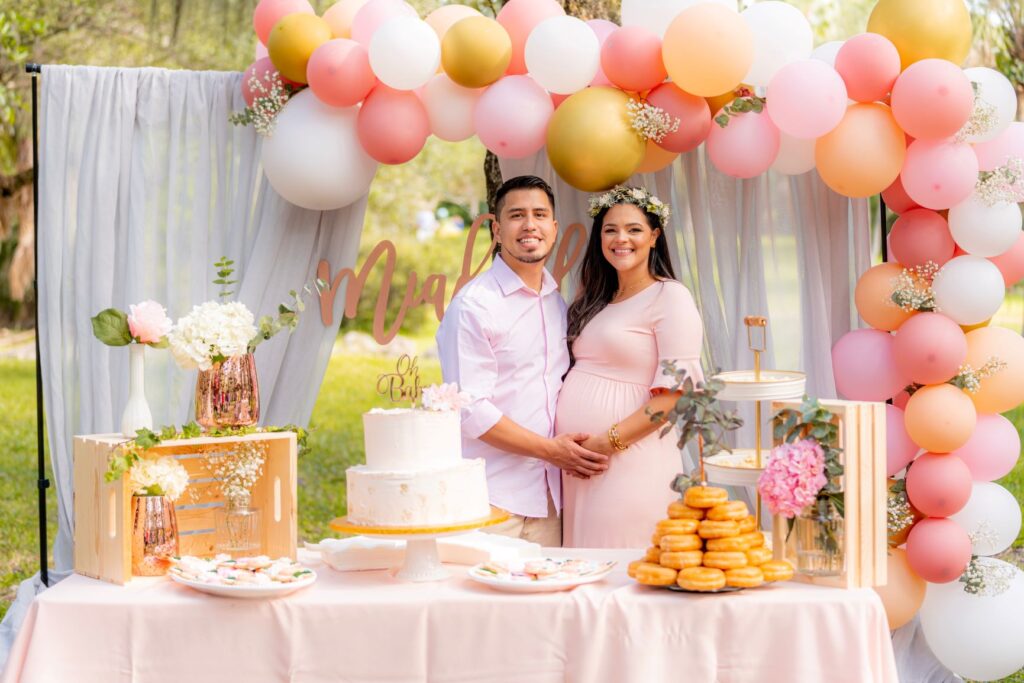
Decoration, food, games etc
Any event can often be wasteful. But it doesn’t have to be. Let’s start with decorations. Try fabric bunting that can be reused. To get even more use out of it use something that says ‘celebrate’ or ‘congratulations’ so that it can be used for many different occasions. Or decorate with fresh flowers from the garden.
Related article: Sustainable party decorations – eco friendly balloon alternatives
Over-catered food is a pet peeve of mine. Consider how many people are coming and how much they’ll actually eat (hint – not everyone will eat a cupcake and certainly not multiple). You can also use real crockery and drink ware instead of disposable plates and cups and a friend of mine even sewed fabric napkins for her baby shower which she now brings out at every child’s birthday party so they are getting plenty of use.
Games do not need to involve small plastic baby bottles or food smeared nappies. The popular peg game can be played with your existing pegs. Other activities like guessing the price of baby items or who’s baby photo can also be zero or low waste.
Related article: How to host an eco-friendly baby shower
How to create an eco friendly nursery
People can get pretty excited about setting up a nursery, especially anyone who has watched the Block and fancies themselves an amateur interior decorator. I’m not usually into decorating rooms but even I had a rare pregnant meltdown because we were trying to squeeze in a spare bed for the in-laws into the nursery which made it impossible to make it look like the images everyone was sharing on social media.
You can have a beautiful looking nursery and still be low waste. Baby furniture is sooo easy to buy second hand. There are oodles of cots and bassinets on Marketplace and Gumtree, you will be spoilt for choice.
And there’s nothing wrong with it at all, people are simply selling it because their children are older and they no longer need a cot, change table, feeding chair etc. You may even be able to get your furniture for free if a close friend is ready to get rid of theirs or you can ask you local Buy Nothing group.
As a bonus, sourcing your nursery furniture second hand can save you a lot of money. Have a look at the prices of new furniture to get you excited about the bargain you’ve nabbed going second hand whilst living sustainably.
To make the room look super cute and Insta-worthy, try buying a few toys from a second hand store or buying artwork from a local market.
Nappies for your eco friendly baby
Modern cloth nappies. MCN. If you’re not familiar with modern cloth nappies, they are made from absorbent material with a waterproof outer layer, shaped like a disposable nappy to fit around the thighs and waist and fasten with velcro or press studs.
And they have a cult following. The main reason – there are so many cute prints! I found myself being swept away with all the funky prints as well as feeling happy that I was avoiding using disposable nappies.
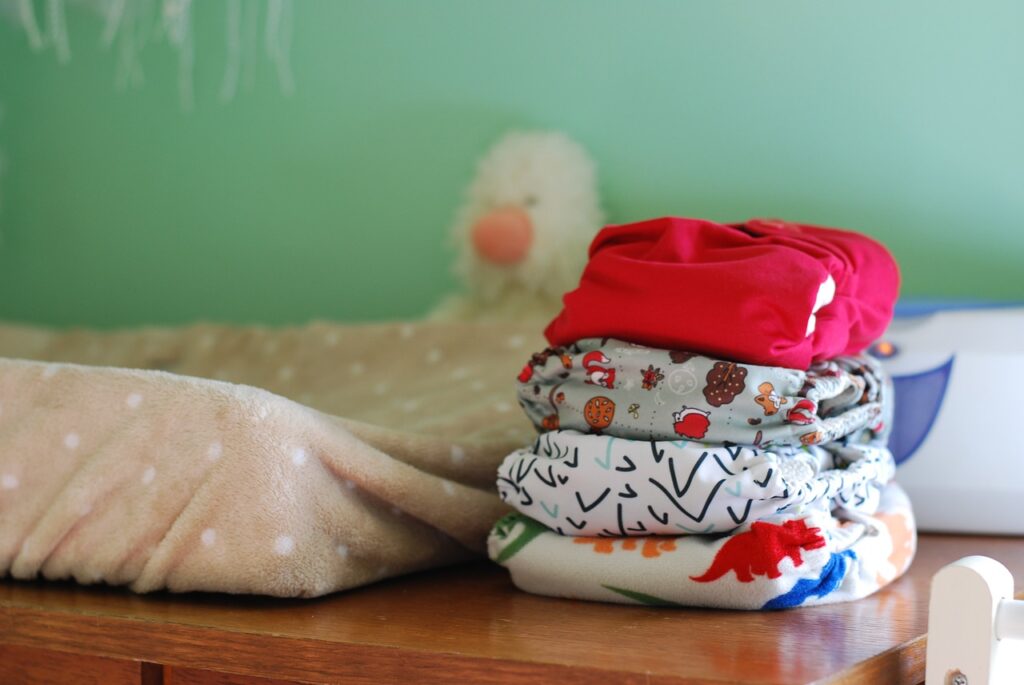
I will admit though that using cloth nappies does require a significant commitment in terms of washing, drying and putting away not to mention carrying around poo covered items in the nappy bag.
It can also be quite costly if you’re buying new but there is the option to hire cloth nappies, like through Australian Cloth Nappy Rental or they are easy to find second hand. There is even a dedicated Facebook group for buying and selling modern cloth nappies in Australia.
If you feel overwhelmed with all the different types and brands of modern cloth nappies, Conquering Motherhood has plenty of advice on the best option for you as well as a guide on how to strip cloth nappies to avoid leaks and keep them smelling fresh.
Another essential resource regarding cleaning cloth nappies in Australia, New Zealand or the UK is Clean Cloth Nappies. The amazing admin can give you advice on a wash routine if you tell them what kind of washing machine you have.
Once you’ve already committed to cloth nappies, you may as well use cloth wipes too. There are plenty of recipes available using coconut oil to moisten the wipes so that they are ready to use on your baby’s delicate behind. Now you’ve avoided both disposable nappies and disposable wipes!
For the times when you need to use disposable nappies, try Ecoriginals. They are made out of mostly plant based materials and minimal plastic whilst offsetting the impact of their products to be carbon neutral.
Whether you decide to use cloth nappies or not, a reusable swim nappy is a must. You need to wash the swim suit anyway so can easily add in the swim nappy. I have also never known a baby to poo in their swim nappy so don’t stress about that.
Clothing for your eco friendly baby
The textile and fashion industry is a huge waste generator. This can be especially true for baby clothes that only get worn for a few months before the child grows out of them and are also likely to get stained with all kinds of food and bodily excrements. So don’t add to the waste generation.
If people insist on buying baby clothes for you, ask that they buy clothes a little bigger so that they’ll get more wear out of them. My son was huge when he was born and skipped a size straight away!
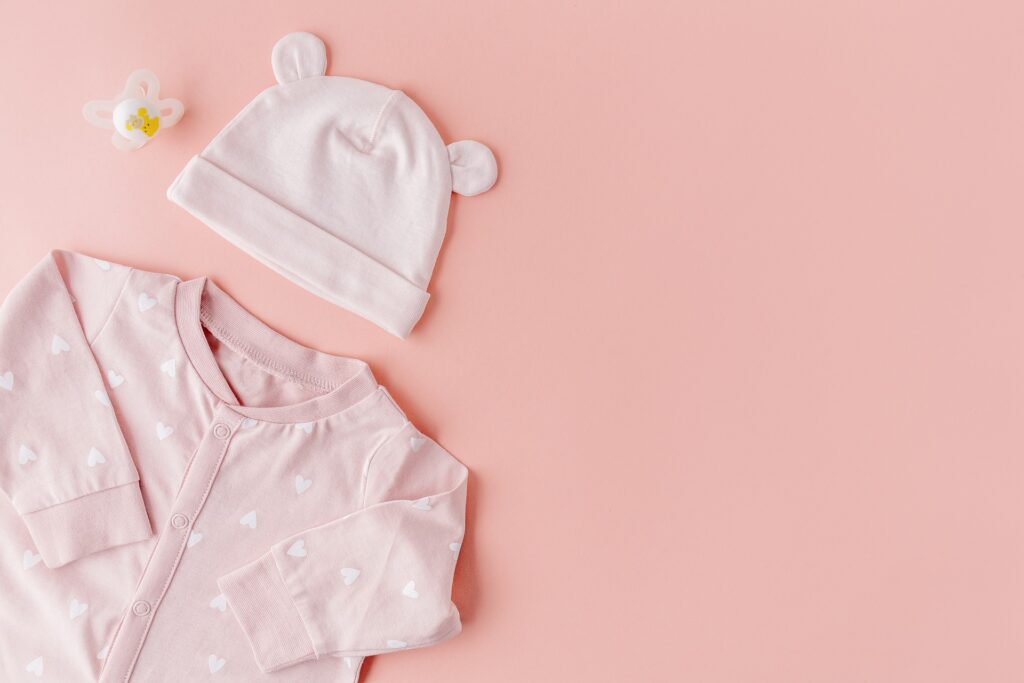
Also be realistic about how many clothes you need. In reality, I’ve found that we have about five of each clothing item that are our favourites and appear on high rotation; the others just sit at the back of the draw in case of emergency.
Also consider the season when you’re buying clothes. A baby will likely go through 3-4 different sizes in the first year so don’t stock up too much on t-shirts in the next size up if they’ll be mostly in long sleeves in a few months anyway. There are actually some great Australian made baby clothes brands that make clothing that grows with your child and will last up to three sizes!
As always, try to buy second hand baby clothes. This will save you dollars as well as the planet. You can select your items at an op shop or alternatively grab huge bundles of clothes off Gumtree or Marketplace for a bargain. And when you’re done with them, you can easily pass them onto another family to use.
Related article: 20+ Places to buy second hand clothes online in Australia
To keep baby clothes in the circular economy, attempt to mend them or remove stains as soon as possible.
You can also consider renting baby clothes since they get used for such a short period. Conscious Koala is an Australian start up where you can subscribe for a monthly fee and they will send a new bundle of clothes each time your baby grows in size. The outgrown clothes are returned to Conscious Koala where they are totally understanding of stains or damage and prepared for use by the next customer or recycled if beyond repair.
If you do buy new clothes, try these organic cotton outfits. Being a natural fibre, they will be much easier to recycle once they come to the end of their life.
Feeding your eco friendly baby
Avoid wasting breast milk
This one may come as a surprise, but breast milk is also a valuable resource that can be wasted. I used a HaaKaa (an amazing device that I can’t rave about enough – see my review here) which allowed me to collect a lot of letdown while I was feeding on the other breast. Breastfeeding was going well for me though, so to avoid the milk being wasted, I froze it in ice cube trays and then transferred to a container in the freezer. See Breastfeeding Mama’s tips for freezing breast milk to avoid it being wasted or unsafe for your baby.
I actually never needed to use my frozen breast milk. When so many people struggle to breastfeed but really want to, I couldn’t bear the thought of throwing it away when it was coming up to it’s three month expiry. My local maternity hospital was not taking donations so I looked further and found a fantastic initiative called Human Milk for Human Babies. You can search for a Facebook group relevant to your location and then post to say that you have milk available for collection. Parents requesting the breast milk are so appreciative, it leaves you with a great feeling too.
Another suggestion for breastfeeding mamas is reuseable cotton breast pads. Leaky breasts are a fact of life when breastfeeding and breast pads will protect your clothes. I started out using some disposable ones I had been given and they were awful. They felt all plastic-y and I could hear them rustle as I moved. Cotton breast pads like these were much more comfortable against my skin as well as being less wasteful.
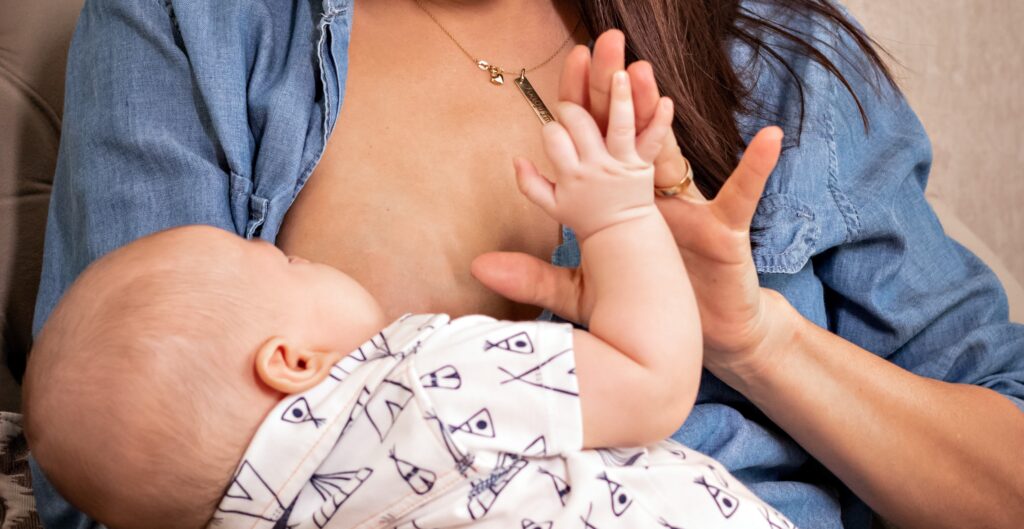
Starting solids
If you’re time-poor (isn’t everyone with a baby?) then buying baby foods can be tempting for convenience but they generate a lot of packaging waste.
I had no interest in store-bought baby food but also refused to spend time making special baby foods. Baby simply ate what the rest of the family was having although slightly modified.
For example if we were having a stir fry with rice for dinner, I would simply remove a bit of the meat and veges, chop it finely and mix with a little mashed sweet potato to make it stick together. And of course there are the zero preparation foods you can offer babies like mashed banana or avocado, yoghurt or softened Weetbix.
For when you’re out and about reuseable food pouches are great. You can fill them with whatever pureed food you like then simply wash and refill. They can be stored in the freezer too. And don’t think that they’ll just be used for a short time when introducing solids. We still use them weekly for my four year old to take yoghurt in her lunchbox.
How to host an eco friendly 1st birthday
1 year old! That is such an exciting milestone for both the baby and parents. Consider exactly how much fanfare is required for a small child who will barely understand what’s happening and perhaps be a bit overwhelmed by it all. For multiple reasons including reducing waste, perhaps consider just a small family gathering.

Same as the baby shower, you could specify no gifts. But many people will not abide by that (I’m looking at you grandparents!). So in order to not be wasteful, consider what you might actually need or want and request those things, especially consumable gifts.
This will likely be the first of many children’s birthday parties. Buy a stack of plastic plates and cups (reuseable ones) that you can bring out at all the future birthday parties rather than resorting to disposables. Avoid over-catering and reuse some of the decorations from your baby shower or buy ones that can be used again for future occasions.
And there is really no need for party favours at a first birthday but if you must, consider a plastic free party bag.
Related article: Environmentally friendly party decorations
So there we are, how to continue on your zero waste journey with a baby. Even if you just implement some of these ideas, you will be having an impact and influencing others. I hope these tips have been helpful; let me know which ones you are keen to try in the comments below.
More articles on living sustainably
- Cleaning Cloth Nappies: Hear From The Experts
- 10 Best Second Hand Baby Clothing Stores Online
- Eco Friendly Mother’s Day Gift Guide
- Eco Friendly Kitchen Sponge Alternatives
- Eco Friendly Zipoc Bag Alternatives
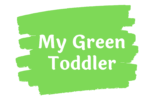
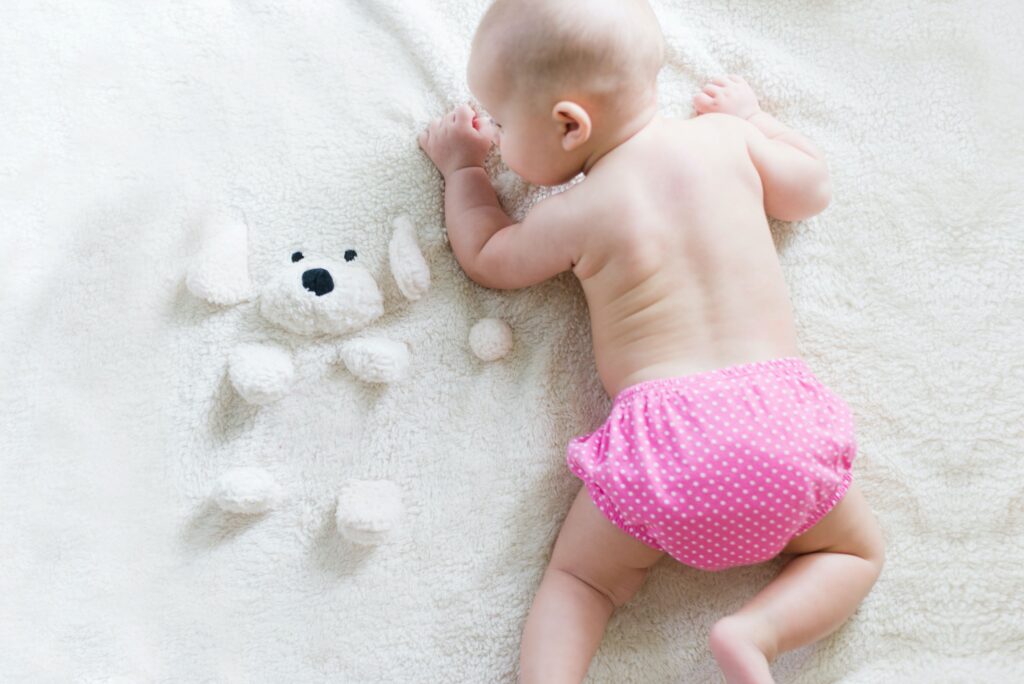
There are so many great things to think about in this post! I also couldn’t bring myself to buy store-bought baby food. Our son ate what we ate as well, and it makes things so simple and easy!
Thanks Rachel 🙂
Great post! I have never really thought much about this, but it’s so important!
These are great ideas. I’m a lot more conscious about waste with this baby and there are some great practical suggestions listed
Such great topic!
I do not consider myself zero waste, but I am trying to be more eco-conscious. I used cloth diapers with my last baby, and I loved it.
This is definitely something, every new mom should read. Great post
I love this. I can only imagine how many diapers and wipes fill up the landfills. It’s sad, but I know that zero waste is not always possible for all. Thank you for giving ideas on how we can make it work!
Very helpful post! We also reuse cups and plates, as well as the decorations from past birthday parties and Christmas celebrations. I feel like there’s always more that one can do, so thank you for your tips.